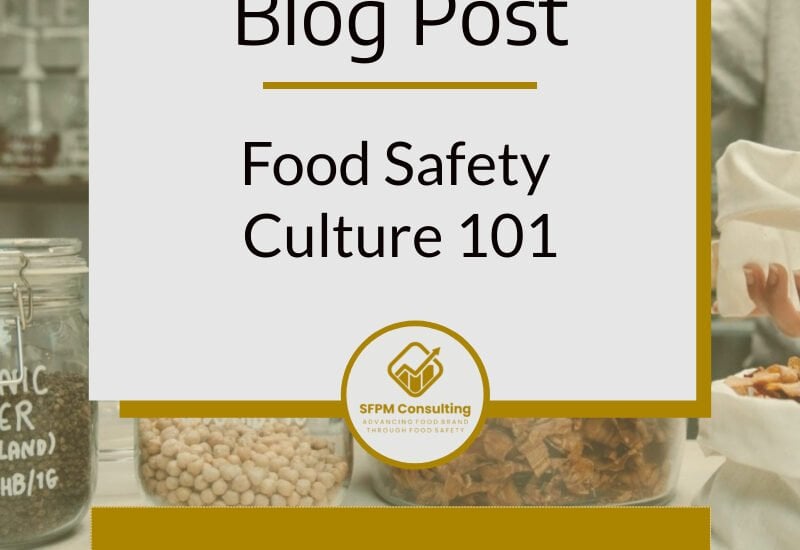Food Safety Culture 101
- March 30, 2021
- Posted by: Felicia L
- Category: Food Safety

Introduction
What is food safety culture?
According to the Global Food Safety Initiative, food safety culture is defined as the “shared values, beliefs and norms that affect mindset and behaviour toward food safety in and throughout an organization.” For example, think about your own facility, think about the common responses that arise when a potential problem rears its head. Do people respond urgently, or is the issue regarded as a nuisance? Your answer to that would qualify as a part of your facility’s food safety culture.
So, why is establishing a positive food safety culture important?
To put it simply, so long as people operate your business, there will always be a need for positive food safety culture. Because despite what we might think, rules don’t run your business or facilities — people do. After all, what use would the perfect set of operational rules be if a culture of nonchalance and dismissal surrounded them? None, those rules might as well not exist at all. This is because culture informs the decisions we make and the actions we take regardless of what’s “on paper.”
That being said, some other reasons as to why establishing a positive food safety culture is so important can pretty much be summed up as mitigating the risk of the following:
- Income loss through product recalls
- Being on the receiving end of legal action from customers negatively affected by faulty products
- Loss of consumer trust (a.k.a they don’t trust you anymore)
Example of negative food safety culture
Identifying negative food safety culture
After reading those risks, you’re probably wondering, “how do I even know what kind of food safety culture my facility has?!?” But don’t worry, we’ve got you covered. Here are a few of the tell-tale signs of bad food safety culture as listed by the Canadian Institute of Food Safety
- Risky food behaviour and poor personal hygiene among food handlers — especially if it isn’t monitored and is going uncorrected by management
- A lack of understanding surrounding what should be done in regards to food safety
- Food Handlers feeling unable to ask for a clearer understanding of your facility’s food safety processes.
- Conversations of food safety are only being brought up when convenient to the bottom line ( a.k.a, when it’s within budget.)
More specifically, poor food culture can manifest in more practical ways, such as
- Failing to store goods at proper temperatures
- Selling goods past their shelf life or when unsure of the good quality
- Failing to prepare foods properly
How to identify negative food safety culture?
In addition to the above, at times, to identify whether your facility has a negative food safety culture or not, you will need to look around and start asking questions such as:
- What does the current food safety program look like?
- How are current food handlers currently handling food?
- Are there any discrepancies in behaviour when a manager is present and when no one is looking?
- Are there any records being kept regarding the quality of food, and are they being recorded consistently?
Tips to improve food safety culture
Improving food safety culture
All of that aside, once you’ve been able to identify your food safety culture shortcomings, your next step should be to get your facility back on track and heading in the right direction. Luckily for you, we’ve listed a few actions you can take to jumpstart this process.
- Start at the top – Ensure that managers, supervisors, and owners are also complying with your facility’s food safety rules and leading by example.
- Properly position food safety- Always position food safety as non-negotiable but encourage employees and managers to maintain a high standard by providing rewards for outstanding performance and consequences for those performing at substandard levels.
- Explain the “Why” – Behind every rule, there is a reason, so be sure to explain it to your employees and management. The days of simply handing someone a list of arbitrary rules are over. When your employees are privy to the importance of your food safety plan, they’ll be more likely and willing to comply.
- Consider hiring a third-party food safety expert – Let’s be honest, when you’ve been with a company for a while, you slowly become desensitized to things over time. This is why having your facility inspected by a fresh pair of eyes is so important. Not only will this party be more objective in their review, but they will also be bringing a career’s worth of expert food-safety knowledge to the table.
Conclusion
In conclusion, when it comes to establishing a positive food safety culture, it’s really a matter of taking the time to be honest about your current situation, being willing to allocate budget to do what is necessary, and creating an environment in which following the rules is just simply a part of what you do and not something you need to get through.
And at an individual facility, the promotion of a positive food safety culture will largely fall on the shoulders of managers. Ensuring that they are properly trained and understand the necessity of positive food safety culture is extremely important.
Are You Looking to Improve Your Food Safety Culture?
We love speaking with you. There are multiple ways that we can help support you in your food safety culture journey, including:
- Training
- Setting up the food safety culture
- Supporting your wellbeing while you are establishing the food safety culture
- Process improvement and optimization -making it easy to build and establish a food safety culture.
Share on Social Media
1 Comment
Comments are closed.

[…] Food Safety Culture 101 […]